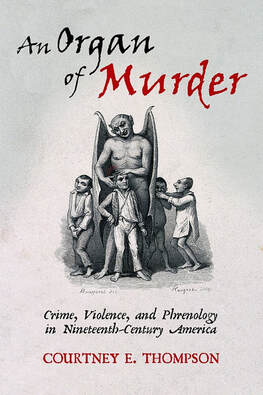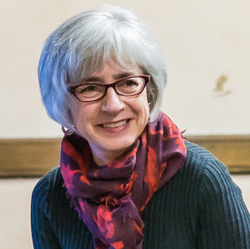Member UpdatesPaige Madison has begun a postdoc at the Natural History Museum of Denmark and University of Copenhagen. Paige is kickstarting a research initiative on the topic of human evolution in the anthropocene while working with Peter Kjærgaard to design a human origins exhibit for the new museum. Publications Courtney E. Thompson's (Mississippi State University) debut book, An Organ of Murder: Crime, Violence, and Phrenology in Nineteenth-Century America (Rutgers University Press, 2021) is now available! An Organ of Murder explores the origins of both popular and elite theories of criminality in the nineteenth-century United States, focusing in particular on the influence of phrenology. In the United States, phrenology shaped the production of medico-legal knowledge around crime, the treatment of the criminal within prisons and in public discourse, and sociocultural expectations about the causes of crime. The criminal was phrenology’s ideal research and demonstration subject, and the courtroom and the prison were essential spaces for the staging of scientific expertise. In particular, phrenology constructed ways of looking as well as a language for identifying, understanding, and analyzing criminals and their actions. This work traces the long-lasting influence of phrenological visual culture and language in American culture, law, and medicine, as well as the practical uses of phrenology in courts, prisons, and daily life. Jaipreet Virdi (University of Delaware) has published "Material Traces of Disability: Andrew Gawley's Steel Hands," Nuncius: Journal of the Material and Visual History of Science 35.3 (2020): 606-621. The December 2020 issue of Isis (111.4) includes a Second Look section designed to address the theme of PANDEMICS across chronological boundaries:
Mary Catherine Bateson, the author of With a Daughter's Eye, agreed to write an article on her famous parents, Margaret Mead & Gregory Bateson for Creative Couples in the Sciences (Rutgers University Press, 1996), edited by Helena M. Pyclor, Nancy G. Slack, and Pnina G. Abir-Am, but she was too busy so Pnina G. Abir-Am wrote it herself (Chapter 17 of the volume). Pnina G. Abir-Am (Brandeis University) wrote a Letter to the Editor to American Scientist protesting the exclusion of six women scientists from four countries from the journal's September 2020 issue, which carried her article "The Women Who Discovered RNA Splicing." Paige Madison (University of Copenhagen) published "Characterized by Darkness: Reconsidering the Origins of the Brutish Neanderthal," in Journal of the History of Biology 53 (2020):493–519. Call for ContributorsCall for Papers: Childbirth Technologies and Techniques
Abstracts Due March 15, 2021 We invite contributions of articles to a special journal issue focusing on the technological culture of childbirth broadly defined. We are particularly interested in how novel technologies, as well as techniques, changed birthing practices over the long term, from the Middle Ages to the present day. We welcome papers on any aspect of this material culture. This especially includes research that nuances claims of technology-as-progress or that complicates existing narratives about the man-midwife’s takeover of midwifery with the forceps. We also welcome new stories about the history of childbirth practices, women’s technological ingenuity, and the very definition of childbirth ‘technology’ itself. This issue aims to generate new discussion about the history of childbirth using material culture as a starting point for thinking about obstetrical practices, technologies, and techniques. We welcome discussion of tools, instruments, and techniques both inside and outside of the birthing chamber, in order to develop a more comprehensive picture of the technological culture around birthing over time. The geographic focus of papers is open and the time period is roughly 1400–present. Technologies and techniques are not limited to the moment of delivery and can focus on pre- and post-partum practices and can include instruments used for diagnostic, anthropometric, practical, quantitative, and educational purposes (e.g. pre-partum diagnostic tools, infant feeding techniques, obstetrical teaching models). We also welcome papers that explore the technological culture of childbirth in relation to gender, race, imperial history, and slavery. For more information.
0 Comments
 A round of applause for Anita Guerrini, who begins her tenure as co-chair of the HSS Women's Caucus! We are immensely grateful to outgoing co-chair Alix Cooper for her work and leadership. Professor Guerrini is a historian of science and medicine, recently retired as Horning Professor in the Humanities at Oregon State University. Her work covers wide-ranging interests, including on anatomy, natural history, the environment, ecological restoration, and the history of food. Her book, The Courtiers' Anatomists: Animals and Humans in Louis XIV's Paris (University of Chicago Press, 2015), received the 2018 HSS Pfizer Prize. She has also published Obesity and Depression in the Enlightenment (University of Oklahoma Press, 2000), Experimenting with Humans and Animals: From Galen to Animal Rights (Johns Hopkins University Press, 2003), Natural History and the New World (American Philosophical Society), and co-edited with Patricia Fumerton Ballads and Broadsides in Britain, 1500-1800 (Ashgate, 2010), among many other works during her illustrious career. |
AboutMonthly newsletter featuring member news, announcements, resources, publications, and more! Archives
February 2022
Categories |
 RSS Feed
RSS Feed
